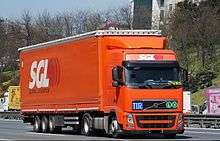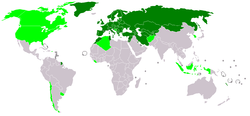TIR Convention
| Convention on International Transport of Goods Under Cover of TIR Carnets | |
|---|---|
|
Contracting Parties to the TIR Convention 1975, in which TIR operations can be established
| |
| Signed | 14 November 1975 |
| Location | Geneva |
| Effective | 20 March 1978 |
| Condition | 5 ratifications |
| Signatories | 17 |
| Parties | 70 |
| Depositary | Secretary-General of the United Nations |
| Languages | English, French and Russian |



The Convention on International Transport of Goods Under Cover of TIR Carnets (TIR Convention) is a multilateral treaty that was concluded at Geneva on 14 November 1975 to simplify and harmonise the administrative formalities of international road transport. (TIR stands for "Transports Internationaux Routiers" or "International Road Transports".) The 1975 convention replaced the TIR Convention of 1959, which itself replaced the 1949 TIR Agreement between a number of European countries.[2] The conventions were adopted under the auspices of the United Nations Economic Commission for Europe (UNECE). As of July 2016, there are 70 parties to the Convention, including 69 states and the European Union.
The TIR Convention establishes an international customs transit system with maximum facility to move goods:
- in sealed vehicles or containers;
- from a customs office of departure in one country to a customs office of destination in another country;
- without requiring extensive and time-consuming border checks at intermediate borders;
- while, at the same time, providing customs authorities with the required security and guarantees.
The TIR system not only covers customs transit by road but a combination is possible with other modes of transport (e.g., rail, inland waterway, and even maritime transport), as long as at least one part of the total transport is made by road.
To date, more than 40,000 international transport operators had been authorised (by their respective competent national authorities) to access the TIR system, using more than 3.2 million TIR carnets per year.
In light of the expected increase in world trade, further enlargement of its geographical scope and the forthcoming introduction of an electronic TIR system (so-called "eTIR-system"), it is expected that the TIR system will continue to remain the only truly global customs transit system.
Due to the large blue-and-white TIR plates carried by vehicles using the TIR convention, the word "TIR" entered many languages, such as Turkish,[3] Polish[4] and Portuguese[5] as a neologism, becoming the default generic name of a large truck.
TIR procedures
Truckers making use of the TIR procedure must first obtain an internationally harmonised customs document, referred to as a TIR carnet. TIR carnets are issued by national road transport associations. This customs document is valid internationally and as well as describing the goods, their shipper and their destination, represents a financial guarantee. When a truck arrives at a border customs post it need not pay import duties and taxes on goods at that time. Instead the payments are suspended. If the vehicle transits the country without delivering any goods, no taxes are due. If it fails to leave the country with all the goods, then the taxes are billed to the importer and the financial guarantee backstops the importer's obligation to pay the taxes. TIR transits are carried out in bond, i.e. the lorry must be sealed as well as bearing the carnet. The security payment system is administered by the International Road Transport Union (IRU).[6]
The TIR procedure is mostly used with Eastern European countries that are not in the EU (e.g. Russia and Ukraine), Turkey, and parts of the Near East. Since the formation of the European single market, the TIR procedure has become unnecessary for intra-EU goods transport.
See also
References
- ↑ "TIR System Countries". United Nations Economic Commission for Europe. Retrieved 23 Jul 2014.
- ↑ UNECE: History of the TIR system
- ↑ http://www.tdk.gov.tr/index.php?option=com_gts&kelime=TIR
- ↑ Słownik Języka Polskiego PWN [retrieved 23-10-2016]
- ↑ http://www.priberam.pt/dlpo/tir
- ↑ "Carnet TIR - TIR Procedure". Swiss Customs Administration. Retrieved 23 Jul 2014.
